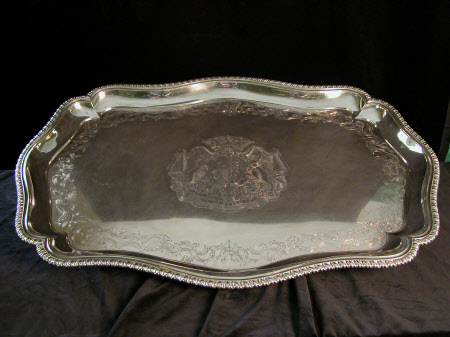Two tea tables
Paolo Antonio Paroletto
Category
Silver
Date
c. 1756
Materials
Silver
Measurements
3.8 x 84.1 x 58.1 cm
Place of origin
Turin
Order this imageCollection
Ickworth, Suffolk
NT 852116
Summary
Two tea tables, silver, by Paolo Antonio Paroletto, Turin, circa 1756. The oblong tables are raised with pulvinating, shaped rims and indented corners and a cast and applied gadroon border. Around the edge of the well of each table is an engraved band of scrollwork emanating from four grotesque masks, one at the centre of each side. Heraldry: The centre of each table is engraved with the quartered shield, supporters and motto of the 2nd Earl of Bristol in an ermine mantling and beneath an earl’s coronet. The style of engraving is Italian (see NT 852078). Hallmarks: Each is marked on the underside with the Turin mint mark of a cross of Savoy with a couped cross on top in a shield below a crown enclosing a trefoil (Augusto Bargoni, ‘Argenti’ in volume 3 of Vittorio Viale (ed.), Mostra del Barocco Piemontese, Turin 1963, p. 15, no. 79, ill.) and the maker’s mark of Paolo Antonio Paraletto (c. 1715–after 1759), St Francis Xavier in the form of a pilgrim above the letters ‘P P A’ (Gianfranco Fina & Luca Mana, Argenti Sabauda del XVIII Secolo, 2012, pp. 235-6, fig. 43). Scratchweights: ‘N٨1 on۸ 237 22/di [struck through][/] 235=0’ and ‘N٨2 on۸ 238 6/di [struck through][/] 235=6’
Full description
These enormous pieces would have been intended for the service of tea, coffee and chocolate and are larger than most others of the period for the same purpose, suggesting the scale of entertainment that the 2nd Earl of Bristol found himself committed to in Turin. They are marked out as Italian by the superb band of rococo engraving on each which has a freedom and lightness of effect rarely achieved in England. The high quality extends to the coat of arms in the centre, which shows a brilliant handling of light and shade and is closely modelled on that in cast form on Ickworth’s round tureens (NT 852128), made in Turin at the same time. The engraver has omitted the tassel finial which should emanate from the velvet cap of the earl’s coronet, and though this could be out of ignorance of British forms it is not absent on any of the other Turin pieces and is likely to be a conscious decision in order to preserve the balance of clear space around the arms. They are perfectly placed and scaled. The shape of the tables is essentially an enlarged, rectangular form of the plates and dishes of Lord Bristol’s dinner service and had come into fashion in England alongside the more typical round and plain oblong varieties c.1750. Two magnificent examples made by Edward Wakelin in 1749 and 1754 are illustrated by Elaine Barr in her study of George Wickes, but they are smaller dimensionally by several inches than Paroletto’s, which are amongst the biggest made in the mid eighteenth century.[1] The Earl must have known exactly what he wanted, and as it was a wholly English form he would have had to describe it to the Turin goldsmith, or to have sketched it out for him. There would presumably also have been designs presented for approval. Other than the canisters of 1738 by Christian Hillan (NT 852066) and the kettle of 1726 by Peter Le Chouabe (NT 852071) no other contemporary tea silver survives at Ickworth and none is listed in the 1811 plate list, where these are described as ‘tea trays’.[2] There would, of course, have been tea spoons which must have been lost or alienated in the late eighteenth century but much of the rest of the tea equipage may well have been porcelain (see NT 852066) given Lord Bristol’s fine collection recorded in a series of inventories surviving in the National Archives.[3] Having a pair of such silver tables was rare but not unheard of, Lord Warrington’s tea and coffee tables still being part of the collection at Dunham Massey with their purpose-made mahogany tripod stands.[4] James Rothwell, Decorative Arts Curator April 2021 [Adapted from James Rothwell, Silver for Entertaining: The Ickworth Collection, London 2017, cat. 58, pp. 144-5.] Notes: [1] Elaine Barr, George Wickes, London 1980, p. 117, figs. 71 and 72. The 1754 table was sold at Sotheby’s, 5 March 1998, lot 231. It weighs slightly more than the Ickworth pair because of the additional cast decoration. [2] Suffolk Record Office, 941/75/1, list of plate of the 5th Earl (later 1st Marquess) of Bristol 1811-29. [3] The National Archives, C 103/174 Hervey – v – Bristol 1762–79 and Patricia Ferguson, ‘Digby, Tollemache and Hervey: three aristocrats and their ceramics’, English Ceramic Circle Transactions, vol. 22 (2011), pp. 72-85. [4] James Lomax and James Rothwell, Country House Silver from Dunham Massey, London 2006, cats. 37 and 38, pp. 88-93.
Provenance
George Hervey, 2nd Earl of Bristol (1721-75); by descent to the 4th Marquess of Bristol (1863-1951); accepted by the Treasury in lieu of death duties in 1956 and transferred to the National Trust.
Credit line
Ickworth, the Bristol Collection (National Trust)
Makers and roles
Paolo Antonio Paroletto, goldsmith

